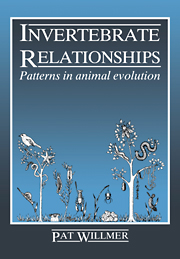2 - Morphological patterns and traditional divisions
Published online by Cambridge University Press: 08 January 2010
Summary
Introduction
Certain features of basic animal design are critical to all schemes of invertebrate phylogeny and thus underlie, explicitly or otherwise, all zoological textbooks and courses. These are features that contribute to our conventional hierarchical view of animals, giving the sort of schemes summarised in chapter 1: the planes of symmetry that distinguish radiate phyla from ‘higher’ bilateral groups, the diploblastic nature of ‘lower’ animals and the added mesoderm giving triploblasty, the presence of varying types of body cavity, or of serial repetitions of structure, and the use of differing systems of skeletal support. Unless we consider the validity of these characters, we can get nowhere in a review of invertebrate phylogeny – they are the very stuff of which theories have been made, the classic comparative morphology against which all other criteria will be judged. This chapter is therefore devoted to a fairly lengthy examination of these topics, and forms both the starting point and in some sense the core of this book.
Patterns of symmetry
Animals are frequently divided in textbooks into the Radiata and the Bilateria, with the implication that as ‘lower’ animals are radially symmetrical so the earliest animals must have begun with that pattern. For the present this latter point will be left aside, as the symmetry of the first metazoans will form a central issue in chapter 7. But it is important here to decide if there is a fundamental difference between the so-called radiate animals and the rest of the animal kingdom.
- Type
- Chapter
- Information
- Invertebrate RelationshipsPatterns in Animal Evolution, pp. 15 - 50Publisher: Cambridge University PressPrint publication year: 1990



